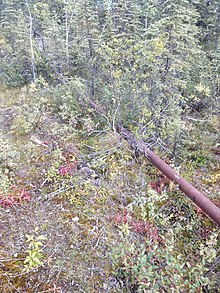
Whitehorse is the capital of Yukon, and the largest city in Northern Canada. It was incorporated in 1950 and is located at kilometre 1426 on the Alaska Highway in southern Yukon. Whitehorse's downtown and Riverdale areas occupy both shores of the Yukon River, which rises in British Columbia and meets the Bering Sea in Alaska. The city was named after the White Horse Rapids for their resemblance to the mane of a white horse, near Miles Canyon, before the river was dammed.

The Municipality and Borough of Skagway is a first-class borough in Alaska on the Alaska Panhandle. As of the 2020 census, the population was 1,240, up from 968 in 2010. The population doubles in the summer tourist season in order to deal with more than 1,000,000 visitors each year. Incorporated as a borough on June 25, 2007, it was previously a city in the Skagway-Yakutat-Angoon Census Area. The most populated community is the census-designated place of Skagway.

Bechtel Corporation is an American engineering, procurement, construction, and project management company founded in San Francisco, California in 1898, and headquartered in Reston, Virginia. As of 2022, the Engineering News-Record ranked Bechtel as the second largest construction company in the United States.

Faro is a town in central Yukon, Canada, the home of the now abandoned Faro Mine. It was the largest open-pit lead–zinc mine in the world as well as a significant producer of silver and other natural resources. The mine was built by the Ralph M. Parsons Construction Company of the United States with General Enterprises Ltd. of Whitehorse being the main subcontractor. As of 2021, the population is 440, down from its peak population of 1,652 in 1981. Faro was named after the card game of the same name.
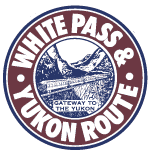
The White Pass and Yukon Route is a Canadian and U.S. Class III 3 ft narrow-gauge railroad linking the port of Skagway, Alaska, with Whitehorse, the capital of Yukon. An isolated system, it has no direct connection to any other railroad. Equipment, freight and passengers are ferried by ship through the Port of Skagway, and via road through a few of the stops along its route.
Enbridge Inc. is a multinational pipeline and energy company headquartered in Calgary, Alberta, Canada. Enbridge owns and operates pipelines throughout Canada and the United States, transporting crude oil, natural gas, and natural gas liquids. Enbridge's pipeline system is the longest in North America and the largest oil export pipeline network in the world. Its crude oil system consists of 28,661 kilometres of pipelines. Its 38,300 kilometre natural gas pipeline system connects multiple Canadian provinces, several US states, and the Gulf of Mexico. The company was formed by Imperial Oil in 1949 as the Interprovincial Pipe Line Company Limited to transport Alberta oil to refineries. Over time, it has grown through acquisition of other existing pipeline companies and the expansion of their projects. Between 2012 and 2021, Enbridge transported over 32 billion barrels of crude oil.
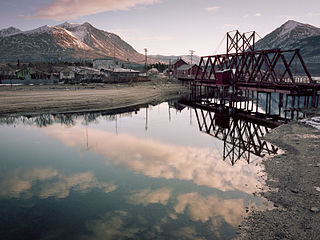
Carcross, originally known as Caribou Crossing, is an unincorporated community in Yukon, Canada, on Bennett Lake and Nares Lake. It is home to the Carcross/Tagish First Nation.

The Canol Road was part of the Canol Project and was built to construct a pipeline from Norman Wells, Northwest Territories, to Whitehorse, Yukon, during World War II. The pipeline no longer exists, but the 449 kilometres (279 mi) long Yukon portion of the road is maintained by the Yukon Government during summer months. The portion of the road that still exists in the NWT is called the Canol Heritage Trail. Both road and trail are incorporated into the Trans-Canada Trail.

Norman Wells is a town located in the Sahtu Region, Northwest Territories, Canada. The town, which hosts the Sahtu Regional office, is situated on the north side of the Mackenzie River and provides a view down the valley of the Franklin and Richardson mountains.

Stanlow Refinery is an oil refinery owned by Essar Energy in Ellesmere Port, North West England. Until 2011 it was owned by Shell UK. The refinery is situated on the south bank of the Manchester Ship Canal, which is used to transport seaborne oil for refining and chemicals for Essar and Shell.

Petroleum production in Canada is a major industry which is important to the economy of North America. Canada has the third largest oil reserves in the world and is the world's fourth largest oil producer and fourth largest oil exporter. In 2019 it produced an average of 750,000 cubic metres per day (4.7 Mbbl/d) of crude oil and equivalent. Of that amount, 64% was upgraded from unconventional oil sands, and the remainder light crude oil, heavy crude oil and natural-gas condensate. Most of the Canadian petroleum production is exported, approximately 600,000 cubic metres per day (3.8 Mbbl/d) in 2019, with 98% of the exports going to the United States. Canada is by far the largest single source of oil imports to the United States, providing 43% of US crude oil imports in 2015.

The Canol Heritage Trail is a 350-kilometre-long (220 mi) trail running from Norman Wells, Northwest Territories, through the Mackenzie Mountains, to the Yukon border. Because of its remoteness, length and river crossings it is considered one of the most challenging trails in Canada. The trail is in the process of becoming a territorial park.

The Sahtu Region is an administrative region in Canada's Northwest Territories. Coterminous with the settlement region described in the 1993 Sahtu Dene and Metis Comprehensive Land Claim Agreement, 41,437 km2 (15,999 sq mi) of the Sahtu is collectively owned by its Indigenous Sahtu (Dene) and Métis inhabitants. Although the region's population is predominantly First Nations, a significant non-Indigenous presence exists in Norman Wells, the regional office, established in 1920 to serve the only producing oilfield in the Canadian Territories. Considered to be of vital strategic importance during World War II in the event of a Japanese invasion of Alaska, the region's petroleum resources were exploited by the United States Army with the Canol pipeline, but the project never became necessary and ultimately operated for less than one year.

Canada's early petroleum discoveries took place near population centres or along lines of penetration into the frontier.

Hanousek v. United States, 176 F.3d 1116, was a decision by the United States Court of Appeals for the Ninth Circuit, which held that ordinary negligence was the legal standard for criminal negligence under the Clean Water Act.

The Irving Oil Refinery is a Canadian oil refinery located in Saint John, New Brunswick. It is currently the largest oil refinery in Canada, capable of producing more than 320,000 barrels (51,000 m3) of refined products per day. Over 80 per cent of the production is exported to the United States, accounting for 19 per cent of the country's gasoline imports and 75 per cent of Canada's gasoline exports to the US.
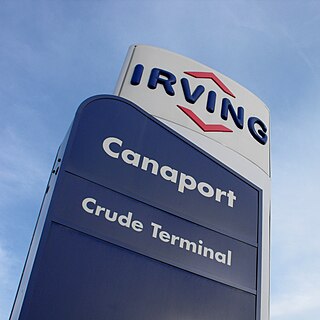
Canaport is a Canadian marine crude oil receiving terminal located on the north shore of the Bay of Fundy at Mispec Point, approximately 9 km (5.6 mi) southeast of the city of Saint John, New Brunswick.
The Canol shale play is the name for a region of Canada's Northwest Territories that is being investigated as a potential source of tight oil . The region centers around the known reserves of conventionally exploitable petroleum at Norman Wells.
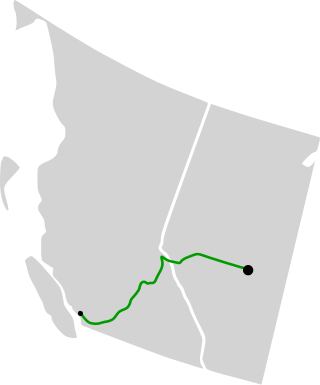
The Trans Mountain Pipeline System, or simply the Trans Mountain Pipeline(TMPL), is a multiple product pipeline system that carries crude and refined products from Edmonton, Alberta to the coast of British Columbia, Canada.

Edward Blondin was a member of the Sahtu Dene First Nation, who played a prominent role in the industrial development of Canada's north. CBC News quotes one of his descendants describing how it was Blondin who first drew the attention of developers to the oil reserves at Tulita, on the Mackenzie River. This deposit was to play an important role in the building of the Alaska Highway. Blondin was one of the guides who found a route for the Canol pipeline that supplied the teams constructing the Alaska Highway with gas from Tulita.
